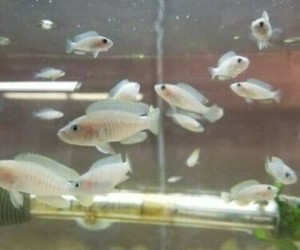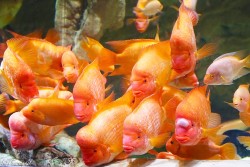Shell Dweller Cichlid (Neolamprologus multifasciatus) CareSheet

This cichlid species may be the world's tiniest cichlid, but it has a tremendous personality and makes for an interesting aquarium topic!
The Shell Dweller Cichlid (Neolamprologus multifasciatus) is a tiny shell-dwelling cichlid endemic to Africa's Lake Tanganyika's deep shoreline sections. Males grow to a maximum of 2 inches and females develop to a maximum of 1.5 inches, making this fish the smallest of all cichlid species. It has grown in popularity in the aquarium hobby in recent years, although it is very uncommon owing to its sluggish growth rate and tiny spawn size. It eggs in the empty shells of Neothauma tanganyicense snails in the wild. When in full breeding state, this fish is white or silver in color with gray to black striping and pastel tints. Red colour around the top of the dorsal fin is common in mature males.
In an aquarium with limited aquascaping, the Shell Dweller Cichlid will flourish. It should be given with multiple empty shells, which do not have to be of the Neothauma tanganyicense species, since it is a shell-dweller. Mature fish will often claim and defend a small region around their home shells. Because this cichlid enjoys digging, a deep sand substrate bed should be supplied if feasible. This species is modest in size, yet it is very territorial when it comes to its own kind and related fish. During spawning, territoriality is usually at its height. Shell Dweller Cichlids should not be housed alongside dwarf shrimp or other tiny, sensitive invertebrates. If spawning is desired, other species should be kept to a minimum or avoided entirely unless the aquarium is large enough with enough of cover and aquascaping.
The uncomplicated Shell Dweller Cichlid is easy to feed.
Freeze dried plankton,
vegi flake food, frozen, and live meaty items of high quality will all be welcomed. This species should not be fed dry items entirely since quality and diversity are the keys to a diet that will guarantee that it maintains maximum health and colour.
Requirements for keeping Neolamprologus multifasciatus
Temperature: 75° - 81° F
pH: 7.5 - 9.0
KH: 8 - 25 KH
Minimum tank size: 10-15 gallons for an adult pair
Origin: Indigenous to Lake Tanganyika, Africa
Average adult size: 2 inches for males, 1.5 inches for females

Neolamprologus multifasciatus
FAQ's
What is the natural habitat of Neolamprologus multifasciatus?
Neolamprologus multifasciatus is native to Lake Tanganyika in East Africa, specifically found in the rocky shorelines and interstitial spaces among shells and rocks in shallow waters.
How small do Neolamprologus multifasciatus typically grow?
Neolamprologus multifasciatus is one of the smallest cichlid species, with adults reaching an average size of about 1.5 to 2 inches (3.8-5 cm) in length.
Can I keep Neolamprologus multifasciatus in a community aquarium?
Neolamprologus multifasciatus is generally peaceful, but it's best to keep them in a species-specific tank or with other Tanganyikan shell-dwelling cichlid species. They may not thrive in a typical community aquarium with larger or more aggressive tankmates.
What are the ideal water parameters for Neolamprologus multifasciatus?
To provide the best care for Neolamprologus multifasciatus, aim for water conditions that replicate their natural habitat:
- pH: 7.8 to 9.0
- Temperature: 74-80°F (23-27°C)
- Water Hardness (GH): 8-20 dGH
What should I feed Neolamprologus multifasciatus?
Neolamprologus multifasciatus are omnivorous and can be fed a varied diet that includes high-quality cichlid pellets or flakes, live or frozen foods like brine shrimp, bloodworms, and small crustaceans. They may also graze on algae in the tank.
How do I set up the perfect aquarium for Neolamprologus multifasciatus?
Creating an ideal habitat for Neolamprologus multifasciatus involves the following steps:
- Use a fine sand substrate to mimic their natural environment.
- Provide numerous shells for them to use as breeding sites and hiding spots.
- Use rocks and other decor to create territories and break lines of sight.
- Maintain proper filtration and perform regular water changes to ensure water quality.
Can Neolamprologus multifasciatus be kept in pairs or groups?
Neolamprologus multifasciatus is a social species and can be kept in groups. In fact, they are known for forming colonies within their territories. A group of these cichlids can be entertaining to observe in a well-designed tank.
How can I tell the difference between male and female Neolamprologus multifasciatus?
Males and females of Neolamprologus multifasciatus are usually similar in size and coloration, making it challenging to distinguish them based on external characteristics. However, males may sometimes exhibit slightly more intense coloration when breeding.
What is the breeding behavior of Neolamprologus multifasciatus?
Neolamprologus multifasciatus are known for their unique breeding behavior. They typically lay their eggs in empty shells or crevices, with the female guarding the eggs while the male protects the territory. The fry will remain within the shells for protection until they are large enough to venture out.
Are there any common health issues that Neolamprologus multifasciatus are prone to?
Like all aquarium fish, Neolamprologus multifasciatus can be susceptible to common diseases such as ich (white spot disease) and bacterial infections. Maintaining optimal water quality, providing a balanced diet, and quarantining new fish before introducing them to an established tank can help prevent health issues.
 This cichlid species may be the world's tiniest cichlid, but it has a tremendous personality and makes for an interesting aquarium topic!
The Shell Dweller Cichlid (Neolamprologus multifasciatus) is a tiny shell-dwelling cichlid endemic to Africa's Lake Tanganyika's deep shoreline sections. Males grow to a maximum of 2 inches and females develop to a maximum of 1.5 inches, making this fish the smallest of all cichlid species. It has grown in popularity in the aquarium hobby in recent years, although it is very uncommon owing to its sluggish growth rate and tiny spawn size. It eggs in the empty shells of Neothauma tanganyicense snails in the wild. When in full breeding state, this fish is white or silver in color with gray to black striping and pastel tints. Red colour around the top of the dorsal fin is common in mature males.
This cichlid species may be the world's tiniest cichlid, but it has a tremendous personality and makes for an interesting aquarium topic!
The Shell Dweller Cichlid (Neolamprologus multifasciatus) is a tiny shell-dwelling cichlid endemic to Africa's Lake Tanganyika's deep shoreline sections. Males grow to a maximum of 2 inches and females develop to a maximum of 1.5 inches, making this fish the smallest of all cichlid species. It has grown in popularity in the aquarium hobby in recent years, although it is very uncommon owing to its sluggish growth rate and tiny spawn size. It eggs in the empty shells of Neothauma tanganyicense snails in the wild. When in full breeding state, this fish is white or silver in color with gray to black striping and pastel tints. Red colour around the top of the dorsal fin is common in mature males.



